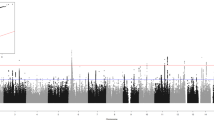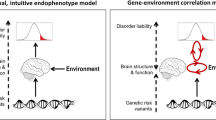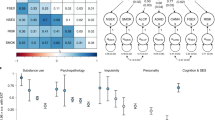Abstract
Major changes in psychiatric phenotypes due to genetic factors are seldom the result of single gene polymorphisms, but more often the result of several genetic mechanisms. In this millennium article we discuss the notion that the expression of numerous candidate genes could be regulated by the same transcription factors, and that polymorphisms in transcription factor genes might explain some phenotypes. We describe recent results of studies on the biological marker thrombocyte monoamine oxidase (trbc MAO) and the transcription factor AP-2β. Low levels of trbc MAO is associated with temperamental characteristics such as sensation seeking and impulsiveness, and the enzyme is genetically regulated by specific transcriptional mechanisms. Transcription factor AP-2β is important for the development of midbrain structures and AP-2β has several binding sites in the regulatory regions of genes encoding key proteins in the monoamine transmitter systems. We have recently shown AP-2β to be linked to personality, binge-eating disorder, treatment with antidepressant drugs, and also to trbc MAO. Regardless of whether transcriptions factors, such as AP-2β, regulate the expression of eg, the number of monoamine neurons or a variety of candidate genes within the monoamine systems, or both, we would like to emphasize the role of transcription factors, besides polymorphisms in monoaminergic candidate genes, when explaining inter-individual differences in temperament and psychiatric vulnerability.
This is a preview of subscription content, access via your institution
Access options
Subscribe to this journal
Receive 12 print issues and online access
$259.00 per year
only $21.58 per issue
Buy this article
- Purchase on Springer Link
- Instant access to full article PDF
Prices may be subject to local taxes which are calculated during checkout

Similar content being viewed by others
References
Comings DE . Polygenic inheritance and micro/minisatellites Mol Psychiatry 1998 3: 21–31
Baron M . The search for complex disease genes: fault by linkage or fault by association Mol Psychiatry 2001 6: 143–149
Chen K, Wu HF, Shih JC . The deduced amino acid sequences of human platelet and frontal cortex monoamine oxidase B are identical J Neurochem 1993 61: 187–190
Murphy DL, Wright C, Buchsbaum M, Nichols A, Costa JL, Wyatt RJ . Platelet and plasma amine oxidase activity in 680 normals: sex and age differences and stability over time Biochem Med 1976 16: 254–265
Bridge TP, Soldo BJ, Phelps BH, Wise CD, Francak MJ, Wyatt RJ . Platelet monoamine oxidase activity: demographic characteristics contribute to enzyme activity variability J Gerontol 1985 40: 23–28
Bagdy G, Rihmer Z . Measurement of platelet monoamine oxidase activity in healthy human volunteers Acta Physiol Hung 1986 68: 19–24
Pedersen NL, Oreland L, Reynolds C, McClearn GE . Importance of genetic effects for monoamine oxidase activity in thrombocytes in twins reared apart and twins reared together Psychiatry Res 1993 46: 239–251
Oreland L, Hallman J . The correlation between platelet MAO activity and personality_a short review of findings and a discussion on possible mechanisms, In: Yu PU, Tipton KF, Boulton AA (eds). Progress in Brain Research Vol 106: Elsevier: Amsterdam 1995 pp 77–84
Schalling D, Åsberg M, Edman G, Oreland L . Markers for vulnerability to psychopathology: temperament traits associated with platelet MAO activity Acta Psychiatr Scand 1987 76: 172–182
Redmond DE, Murphy DL, Baulu J . Platelet monoamine oxidase activity correlates with social affiliative and agonistic behaivors in normal rhesus monkeys Psychosom Med 1979 41: 87–100
Usberg M, Oreland L, Garpenstrand H, Damberg M, Ekblom J, Forslund K et al. Thrombocyte-MAO and transcription factor AP-2 are related to personality—is there a connection? 38th ACNP, Acapulco, Mexico, Dec 1999
Sostek AJ, Sostek AM, Murphy DL, Martin EB, Born WS . Cord blood amine oxidase activities relate to arousal and motor functioning in human newborns Life Sci 1981 28: 2561–2568
af Klinteberg B, Oreland L, Hallman J, Wirsen A, Levander SE, Schalling D . Exploring the connections between platelet monoamine oxidase activity and behavior: relationships with performance in neuropsychological tasks Neuropsychobiology 1990–91 23: 188–196
Grimsby J, Toth M, Chen K, Kumazawa T, Klaidman L, Adams JD et al. Increased stress response and beta-phenylethylamine in MAOB-deficient mice Nat Genet 1997 17: 206–210
Oreland L . Monoamine oxidase in neuropsychiatric disorders. In: Yusahara H, Parvez SH, Ogushi K, Sandler M, Nagatsu T (eds) Monoamine Oxidase—Basic and Clinical Aspects VSP: Utrecht 1993 219–247
Fowler JS, Volkow ND, Wang GJ, Pappas N, Logan J, MacGregor R et al. Inhibition of monoamine oxidase B in the brains of smokers Nature 1996 379: 733–736
Oreland L, Fowler CJ, Schalling D . Low platelet monoamine oxidase activity in cigarette smokers Life Sci 1981 29: 2511–2518
Oreland L, Garpenstrand H, Damberg M, Alm PO, Thorell LH, af Klinteberg B et al. The correlation between platelet MAO activity and personality—the effect of smoking and possible mechanisms behind the correlation Neurobiology (Bp) 1999 7: 191–203
Anthenelli RM, Tipp J, Li TK, Magnes L, Schuckit MA, Rice J et al. Platelet monoamine oxidase activity in subgroups of alcoholics and controls: results from the Collaborative Study on the Genetics of Alcoholism Alcohol Clin Exp Res 1998 22: 598–604
Oreland L, Hallman J . The correlation between platelet MAO activity and personality: short review of findings and a discussion on possible mechanisms Prog Brain Res 1995 106: 77–84
Oreland L, Wiberg A, Asberg M, Traskman L, Sjostrand L, Thoren P et al. Platelet MAO activity and monoamine metabolites in cerebrospinal fluid in depressed and suicidal patients and in healthy controls Psychiatry Res 1981 4: 21–29
Brown GL, Goodwin FK, Ballenger JC, Goyer PF, Major LF . Aggression in humans correlates with cerebrospinal fluid amine metabolites Psychiatry Res 1979 1: 131–139
Kruesi MJ, Rapoport JL, Hamburger S, Hibbs E, Potter WZ, Lenane M et al. Cerebrospinal fluid monoamine metabolites, aggression, and impulsivity in disruptive behavior disorders of children and adolescents Arch Gen Psychiatry 1990 47: 419–426
af Klinteberg B, Oreland L . Hyperactive and aggressive behaviors in childhood as related to low platelet monoamine oxidase (MAO) activity at adult age: a longitudinal study of male subjects Personal Indiv Diff 1995 19: 373–383
Virkkunen M, Linnoila M . Brain serotonin, type II alcoholism and impulsive violence J Stud Alcohol Suppl 1993 11: 163–169
von Knorring L, Oreland L . Platelet MAO activity in type I/type II alcoholics Alcoholism & Alcoholism: Clin Exp Res 1996 20: 224A–230A
Girmen AS, Baenziger J, Hotamisligil GS, Konradi C, Shalish C, Sullivan JL et al. Relationship between platelet monoamine oxidase B activity and alleles at the MAOB locus J Neurochem 1992 59: 2063–2066
Garpenstrand H, Ekblom J, Forslund K, Rylander G, Oreland L . Platelet monoamine oxidase activity is related to MAOB intron 13 genotype J Neural Transm 2000 107: 523–530
Zhu Q-S, Grimsby J, Chen K, Shih JC . Promoter organization and activity of human monoamine oxidase (MAO) A and B genes J Neurosci 1992 12: 4437–4446
Grimsby J, Lan NC, Neve R, Chen K, Shih JC . Tissue distribution of human monoamine oxidase A and B mRNA J Neurochem 1990 55: 1166–1169
Ekblom J, Zhu Q-S, Chen K, Shih JC . Monoamine oxidase gene transcription in human cell lines: treatment with psycho-active drugs and ethanol J Neural Transm 1996 103: 681–692
Prince J, Jia S, Bve U, Anneren G, Oreland L . Mitochondrial enzyme deficiencies in Down's syndrome J Neural Transm 1994 8: 171–181
Ekblom J, Garpenstrand H, Damberg M, Chen K, Shih JC, Oreland L . Transcription factor binding to the core promoter of the human monoamine oxidase B gene in the cerebral cortex and in blood cells Neurosci Lett 1998 258: 101–104
Oulad-Abdelghani M, Bouillet P, Chazaud C, Dollé P, Chambon P . AP-2.2: a novel AP-2 related transcription factor induced by retinoic acid during differentiation of P19 embryonal carcinoma cells Exp Cell Res 1996 224: 338–347
Chazaud C, Oulad-Abdelghani M, Bouillet P, Décimo D, Chambon P, Dollé P . AP-2.2, a novel gene related to AP-2, is expressed in the forebrain, limbs and face during mouse embryogenesis Mech Dev 1996 54: 83–94
Williams T, Tjian R . Analysis of the DNA-binding and activation properties of the human transcription factor AP-2 Genes Dev 1991 5: 670–682
Williams T, Tjian R . Characterization of a dimerization motif in AP-2 and its function in heterologous DNA binding proteins Science 1991 251: 1067–1071
Williams T, Admon A, Luscher B, Tjian R . Cloning and expression of AP-2, a cell-type-specific transcription factor that activates inducible enhancer elements Genes Dev 1988 2: 1557–1569
Bosher JM, Totty NF, Hsuan JJ, Williams T, Hurst HC . A family of AP-2 proteins regulates c-erbB-2 expression in mammary carcinoma Oncogene 1996 13: 1701–1707
Greco D, Zellmer E, Zhang Z, Lewis E . Transcription factor AP-2 regulates expression of the dopamine β-hydroxylase gene J Neurochem 1995 65: 510–516
Moser M, Pscherer A, Imhof A, Bauer R, Kerscher M, Amselgruber W et al. Cloning and characterisation of a second AP-2 transcription activator gene, AP-2β Development 1995 121: 2779–2788
Roesler WJ, Vandenbark GR, Hanson RW . Cyclic AMP and the induction of eukaryotic gene transcription J Biol Chem 1988 263: 9063–9066
Shimada M, Konishi Y, Ohkawa N, Othaka-Marutama C, Hanaok F, Makino Y et al. Distribution of AP-2 subtypes in the adult mouse brain Neurosci Res 1999 33: 275–280
Moser M, Pscherer A, Roth C, Becker J, Mücher G, Zerres K et al. Enhanced apoptotic cell death of renal epithelial cells in mice lacking transcription factor AP-2β Genes Dev 1997 11: 1938–1948
Kobayashi K, Kurosawa Y, Fujita K, Nagatsu T . Dopamine β-hydroxylase gene: two mRNA types having different 3′-terminal regions are produced through alternative polyadenylation Nucleic Acids Res 1989 17: 1089–1102
McMahon M, Sabban E . Regulation of expression of dopamine β-hydroxylase in PC12 cells by glucocorticoids and cyclic AMP analogues J Neurochem 1992 59: 2040–2047
Healy DP, O'Rourke DA . Regulation of dopamine-1A (DIA) receptor gene transcription Clin Exp Hypertens 1997 19: 1–13
Hahn SL, Hahn M, Kang UJ, Joh TH . Structure of the rat aromatic L-amino acid decarboxylase gene: evidence for an alternative promoter usage J Neurochem 1993 60: 1058–1064
Bradely CC, Blakely RD . Alternative splicing of the human serotonin transporter gene J Neurochem 1997 69: 1356–1367
Du YL, Wilcox BD, Teitler M, Jeffrey JJ . Isolation and characterization of the rat 5-hydroxytryptamine type 2 receptor promoter: constitutive and inducible activity in myometrial smooth muscle cells Mol Pharmacol 1994 45: 1125–1131
Valdenaire O, Vernier P, Maus M, Dumas Milne Edwards JB, Mallet J . Transcription of the rat dopamine-D2-receptor gene from two promoters Eur J Biochem 1994 220: 577–584
Boularand S, Darmon MC, Ravassard P, Mallet J . Characterization of the human tryptophan hydroxylase gene promoter. Transcriptional regulation by cAMP requires a new motif distinct from the cAMP-responsive element J Biol Chem 1995 270: 3757–3764
Enzhong X, Lingyun Z, Long-Sheng C . The human serotonin 5-HT2c receptor: complete cDNA, genomic structure and alternatively spliced variant Genomics 1996 35: 551–561
Damberg M, Garpenstrand H, Forslund K, Rylander G, Oreland L . A polymorphic region in the human transcription factor AP-2β gene is associated with specific personality traits Mol Psychiatry 2000 5: 220–224
Damberg M, Garpenstrand H, Berggard C, Asberg M, Hallman J, Oreland L . The genotype of human transcription factor AP-2beta is associated with platelet monoamine oxidase B activity Neurosci Lett 2000 291: 204–206
Damberg M, Ekblom J, Oreland L . Chronic pharmacological treatment with certain antidepressants alters the expression and DNA-binding activity of transcription factor AP-2 Life Sci 2000 68: 669–678
Stallings MC, Hewitt J-K, Cloninger CR, Heath AC, Eaves LJ . Genetic and environmental structure of the tridimensional personality questionnaire: three or four temperament dimensions J Pers Soc Psychol 1996 70: 127–140
Watson D, Clark LA . Negative affectivity: the disposition to experience aversive emotional states Psychol Bull 1984 96: 465–490
Helleday J, Edman G, Rietzen EM, Siwers B . Personality characteristics and platelet MAO activity in women with congenital adrenal hyperplasia (CAH) Psychoneuroendocrinology 1993 18: 343–354
Brewerton DT . Toward a unified theory of serotonin dysregulation in eating and related disorders Psychoneuroendocrinology 1995 20: 561–590
Linnoila M, Virkkunen M, George T, Higley D . Impulse control disorders Int Clin Psychopharmacol 1993 8 Suppl 1: 53–56
Lesch KP, Merschdorf U . Impulsivity, aggression, and serotonin: a molecular psychobiological perspective Behav Sci Law 2000 18: 581–604
Hallman J, Oreland L, Edman G, Schalling D . Thrombocyte monoamine oxidase activity and personality traits in women with severe premenstrual syndrome Acta Psychiatr Scand 1987 76: 225–234
Dziedzicka-Wasylewska M, Sobota R, Góralska M, Golembiowska K . Antidepressant drugs decrease the transcriptional activity of dopamine D2 receptor gene promoter in the NB41A3 cells—in vitro study Eur J Neuropsychopharmacol 2001 11 suppl 1: 8
Cyr M, Morisette M, Barden N, Beaulieu S, Rochford J, Di Paolo T . Dopaminergic activity in transgenic mice underexpressing glucocorticoid receptors: effect of antidepressants Neuroscience 2001 102: 151–158
Dziedzicka-Wasylewska M, Rogoz R, Klimek V, Maj J . Repeated administration of antidepressant drugs affects the levels of mRNA coding for D1 and D2 dopamine receptors in the rat brain J Neural Transm 1997 104: 515–524
Catalano M . Psychiatric genetics ’99. The challenges of psychopharmacogenetics Am J Hum Genetics 1999 65: 606–610
Heguy A, Stewart AA, Haley JD, Smith DE, Foulkes JG . Gene expression as a target for new drug discovery Gene Expr 1995 4: 337–344
Butt T, Karathanasis SK . Transcription factors as drug targets: opportunities for therapeutic selectivity Gene Expr 1995 4: 319–336
Hurley HL . DNA and associated targets for drug design J Med Chem 1989 32: 2027–2033
Pennypacker KR . Pharmacological regulation of transcription factor binding Pharmacology 1995 51: 1–12
Oreland L, Shaskan EG . Monoamine oxidase activity as a biological marker Trends Pharmacol Sci 1983 4: 339–341
Faisst S, Meyer S . Compilation of vertebrate-encoded transcription factors Nucleic Acids Res 1992 20: 3–26
Mitchell PJ, Timmons PM, Herbert JM, Rigby PW, Tjian R . Transcription factor AP-2 is expressed in neural crest lineages during mouse embryogenesis Genes Dev 1991 5: 105–119
Moser M, Rüschoff J, Buettner R . Comparative analysis of AP-2α and AP-2β gene expression during murine embryogenesis Dev Dyn 1997 208: 115–124
Hartmann J, Kunig G, Riederer P . Involvement of transmitter systems in neuropsychiatric diseases Acta Neurol Scand Suppl 1993 146: 18–21
Cravchik A, Goldman D . Neurochemical individuality: genetic diversity among human dopamine and serotonin receptors and transporters Arch Gen Psychiatry 2000 57: 1105–1114
Depue RA, Collins PF . Neurobiology of the structure of personality: dopamine, facilitation of incentive motivation, and extraversion Behav Brain Sci 1999 22: 491–569
Zuckerman M . P-impulsive sensation seeking and its behavioral, psychophysiological and biochemical correlates Neuropsychobiology 1993 28: 30–36
Koob GF, Nestler EJ . The neurobiology of drug addiction J Neuropsychiatry Clin Neurosci 1997 9: 482–497
Collier DA, Stober G, Li T, Heils A, Catalano M, Di Bella D et al. A novel functional polymorphism within the promoter of the serotonin transporter gene: possible role in susceptibility to affective disorders Mol Psychiatry 1996 1: 453–460
Hallikainen T, Saito T, Lachman HM, Volavka J, Pohjalainen T, Ryynanen OP et al. Association between low activity serotonin transporter promoter genotype and early onset alcoholism with habitual impulsive violent behavior Mol Psychiatry 1999 4: 385–388
Baker H, Joh TH, Reis DJ . Genetic control of number of midbrain dopaminergic neurons in inbred strains of mice: relationship to size and neuronal density of the striatum Proc Natl Acad Sci USA 1980 77: 4369–4373
Fink JS, Reis DJ . Genetic variations in midbrain dopamine cell number: parallel with differences in responses to dopaminergic agonists and in naturalistic behaviors mediated by central dopaminergic systems Brain Res 1981 222: 335–349
Author information
Authors and Affiliations
Corresponding author
Rights and permissions
About this article
Cite this article
Damberg, M., Garpenstrand, H., Hallman, J. et al. Genetic mechanisms of behavior—don't forget about the transcription factors. Mol Psychiatry 6, 503–510 (2001). https://doi.org/10.1038/sj.mp.4000935
Received:
Accepted:
Published:
Issue Date:
DOI: https://doi.org/10.1038/sj.mp.4000935
Keywords
This article is cited by
-
Transcription Factor Activating Protein-2β (TFAP-2β) genotype and symptoms of attention deficit hyperactivity disorder in relation to symptoms of depression in two independent samples
European Child & Adolescent Psychiatry (2014)
-
The dynorphin/κ-opioid receptor system and its role in psychiatric disorders
Cellular and Molecular Life Sciences (2012)
-
The Transcription Factor TFAP2B Is Associated With Insulin Resistance and Adiposity in Healthy Adolescents
Obesity (2009)
-
Transcription factor AP-2β genotype and psychosocial adversity in relation to adolescent depressive symptomatology
Journal of Neural Transmission (2009)
-
The molecular genetic architecture of human personality: beyond self-report questionnaires
Molecular Psychiatry (2006)



